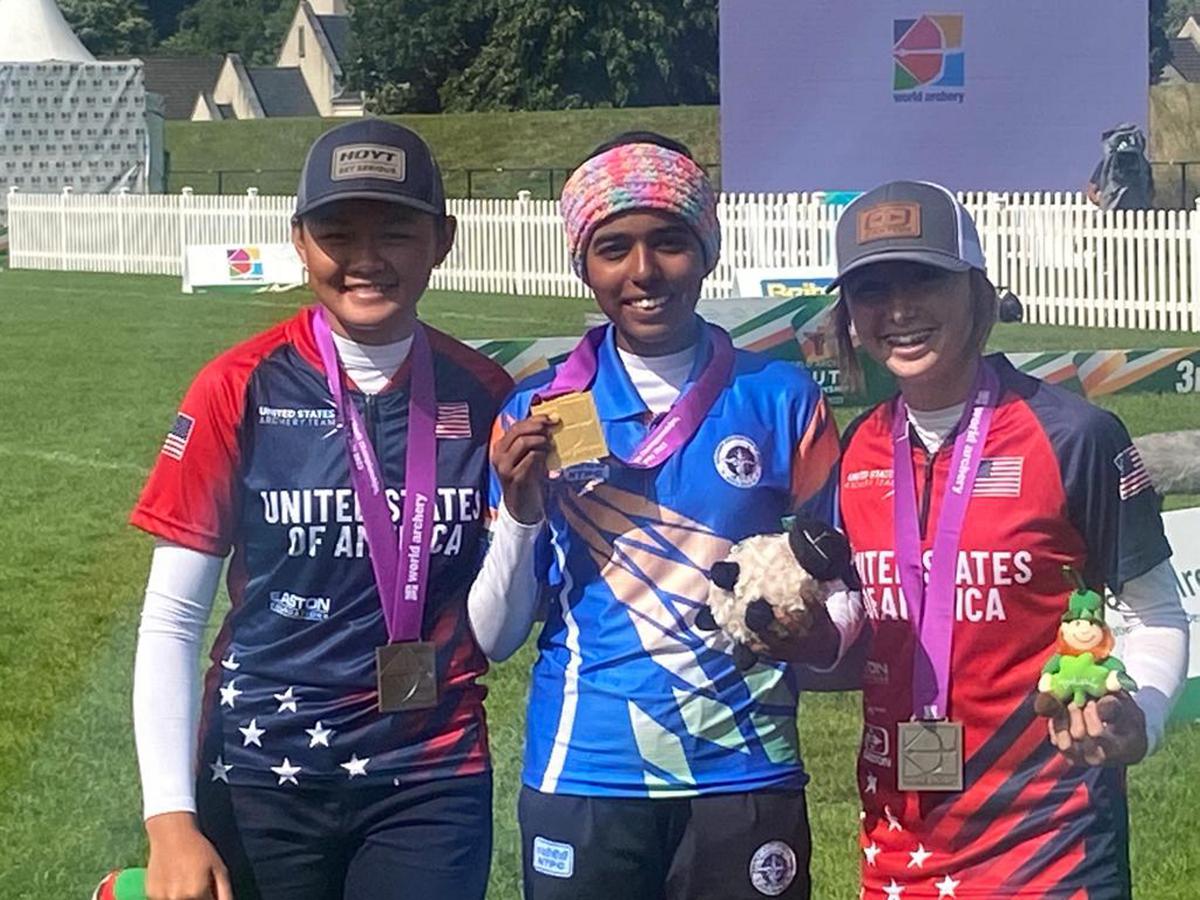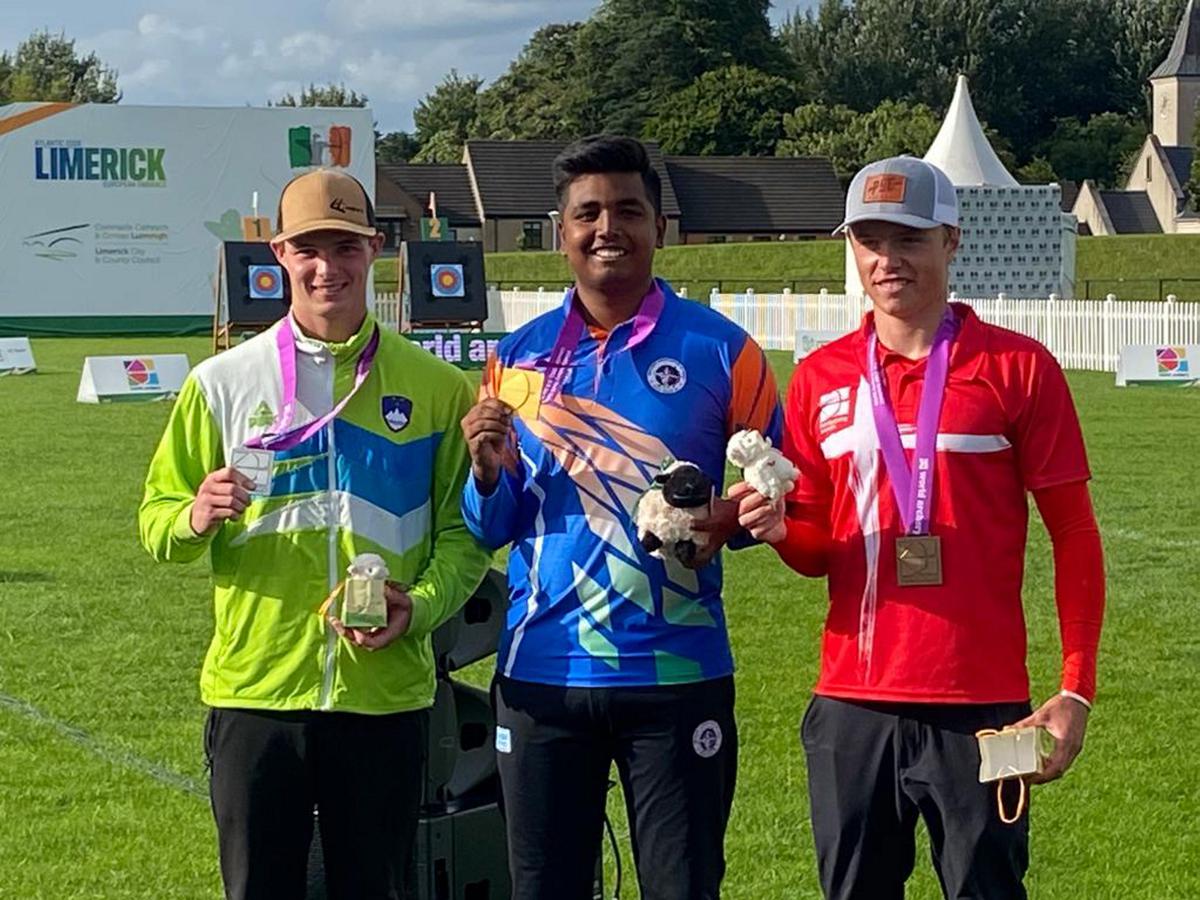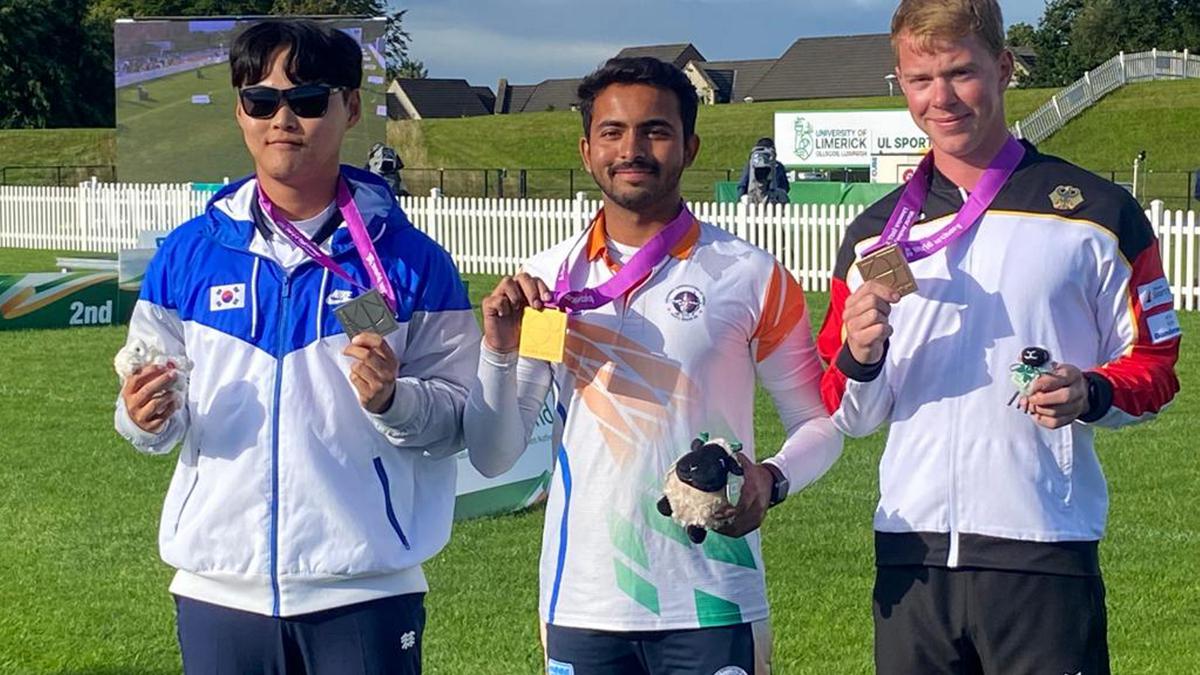India’s young archers battle adversity to hit the target

Prodigious talent: Aditi Swami (centre) claimed the under-18 women’s compound crown on the back of her World Record score (711 out of 720 points) at the World Cup Stage-3 in mid-June, underlining her status as the new wonder girl of Indian archery. | Photo credit: PTI

Calm amid the storm: Priyansh (centre) relied on his cool temperament to overcome the windy conditions and corner glory in the under-21 men’s compound category.| Photo credit: PTI
In the harshest of conditions and toughest of fields at the World Youth Championships, featuring under-18 and under-21 competitions, in Limerick, Ireland, last month, Indian archers collected the highest number of medals (11) to paint a bright picture of the future.
India’s tally, including three gold medals apiece in the individual and team events, reduced by four medals in comparison with the previous edition in Wroclaw two years ago, but the archers’ consistency despite the increased odds speaks of the quality of the country’s youngsters.
Even though Russia (which won four medals in 2021) was absent in Limerick, the field became a lot tougher because of the entry of countries such as powerhouse Korea (which topped the table with 11 medals including six gold, four silver and one bronze), China (four), Great Britain (three) and Chinese Taipei (two).
Against the odds
“This time the performance came in very adverse conditions. It was chilly, raining and windy, but we did very well. Last time China and Korea, two major contenders, were not there. Despite that we had the highest number of medals. The gold against Korea [Parth Salunkhe beat Injun Song to win the under-21 recurve men’s individual title] was special,” said Sanjeeva Singh, the Indian team’s high performance director.
Salunkhe, who had claimed a mixed team gold and men’s team gold in 2021, was delighted with his individual crown. “I worked on my approach — physically and mentally. I noticed that archers from successful countries such as Korea and China were focusing on their roots. So I tried going to our roots and practised yoga and meditation. Archery is a mental sport and we always lagged [in terms of] focusing and controlling our heartbeat. Yoga and meditation help one in clear thinking and focusing,” said Salunkhe, who recovered from a shoulder issue last year.
“The individual gold has given me a lot of confidence. While Paris 2024 remains on my radar, my main target is the 2028 Olympics. I want to win not just an Olympic medal, but an Olympic gold medal. I need to overcome my weaknesses and build my game gradually to that level.”
India’s recurve archers winning four out of the 11 medals was a morale booster (as recurve is part of the Olympics). The bronze medals claimed by Bhajan Kaur (under-21 women’s individual), the under-21 mixed team (Ridhi Phor and Salunkhe) and the under-18 men’s team (Agastya Singh, Ujjwal Dhama and Goldi Mishra) added to Salunkhe’s gold.
India is comparatively stronger in compound archery. It was noticeable in Limerick as well. Priyansh (under-21 men’s individual), Aditi Swami (under-18 women’s individual), the under-21 mixed team (Avneet Kaur, Priyansh), the under-21 women’s team (Avneet, Parneet Kaur and Pragati) and the under-18 women’s team (Ekta Rani, Aishwarya Sharma and Aditi) claimed gold medals, while the under-18 men’s team (Pawan Gat, Manav Jadhao, T. Ganesh Mani Ratnam) took the lone silver. Aishwarya and Jadhao picked up the mixed team bronze.
Seventeen-year-old Aditi — who hails from Maharashtra’s Satara like Salunkhe and Olympian Pravin Jadhav (who is her role model) — excelled amid new challenges to win the under-18 crown on the back of her World Record score (711 out of 720 points) in the World Cup Stage-3 in mid-June and underlined her status as the new wonder girl of Indian archery.
“In Ireland it was really difficult. Since my body-weight is less, I could not control myself because of the strong wind. Taking aim was difficult. I overcame this by shooting fast and relying on self-belief. My personal coach Pravin Sawant’s presence also helped. I learnt how to judge the conditions and not to repeat mistakes,” said Aditi, who won a historic team gold at the World Championships in Berlin on Friday.
Delhi lad Priyansh relied on his sound game and cool temperament to corner glory in his second World youth outing. “In Ireland, we had testing conditions. We accepted the conditions and didn’t bother about them. We were prepared to face such conditions. We just focused on our shooting,” said Priyansh, who has gained from training alongside the experienced Abhishek Verma at the Yamuna Sports Complex.
“Competing with the senior athletes in domestic events helps. In compound, the competition is so tough that by the time one reaches the international stage one becomes used to shooting in top class events and doesn’t feel the pressure. Today, in National events, around 20 archers shoot 700-plus scores. In 2021, three or four used to log 700-plus scores,” added Priyansh.
Stress-testing talent
Sanjeeva provides some perspective on pitting younger athletes against experienced ones at the elite level and giving them sufficient competitive opportunities, nationally and internationally. He feels it prepares war-ready archers.
“A domestic circuit, infrastructure, equipment, advanced training with foreign experts and international exposure are the five pillars we are working on. That’s why we are able to perform and create bench strength. If you look at the World Championships, the best part was the bench strength.
“Our juniors, who are in the elite team, went back to junior competitions and won medals. The juniors, who replaced the seniors, have done well. Prathamesh [Jawkar] beat [World No.1] Mike Schloesser [on route to gold in the World Cup Stage-2 in Shanghai]. Aditi created a World Record.
“We are looking at the current seniors for the 2024 Olympics and at the youngsters for the 2028 and 2032 Olympics. The mushrooming of centres, including State-sponsored, private-sponsored, individually developed ones and National Centres of Excellence, is boosting the supply line,” said Sanjeeva.
The Arjuna and Dronacharya awardee said tweaking the selection trials also played its part. “The selection process has been modified on the lines of the World Cups and World Championships. Our focus is on elimination rounds. We have created more one-on-one matches. We are giving points for consistency. All this ensures that the team that is selected is the best and gives results.”
Besides, there is a two-pronged strategy to get rid of the habit of shooting slow, said Sanjeeva.
“We are working with the foreign coaches on the technical side and pushing the archers to shoot fast. In windy conditions, if you are able to shoot fast, then you can get good results. In windy conditions, your bow hand will move, your aim will shift and you will not be able to control the shots.
“Now Indian archers are shooting boldly and confidently. That is happening not just at the senior level, but at junior and youth levels.
“The coaches have understood this through seminars. The basic coaching system is stabilising. All the coaches are getting similar knowledge,” said Sanjeeva.
The signs are positive, but the biggest challenge in the years to come will be helping the promising ones to produce consistent results at the highest level and maintaining the health of the development programme.
For all the latest Sports News Click Here
For the latest news and updates, follow us on Google News.

